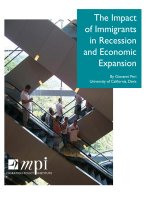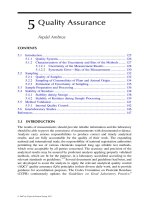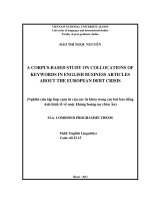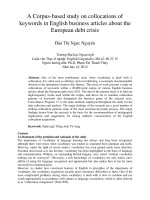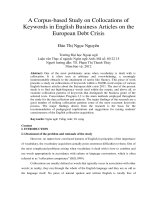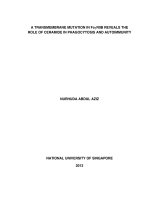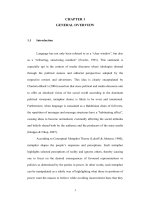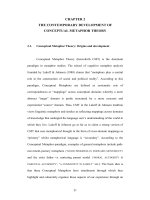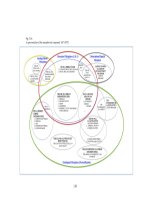The gulf of mexico oil spill a corpus based study of metaphors in british and american media discourse 5
Bạn đang xem bản rút gọn của tài liệu. Xem và tải ngay bản đầy đủ của tài liệu tại đây (2.32 MB, 63 trang )
193
CHAPTER 5
METAPHORS IN BRITISH MEDIA DISCOURSE:
THE GUARDIAN & THE DAILY TELEGRAPH
5.1 Introduction: Metaphorical Evaluation in British Media Discourse
British broadsheets such as The Guardian, The Daily Telegraph, The
Independent and The Times are mainstream daily newspapers with a wide
circulation. Just like in the American context, British broadsheets are seen as
“the fourth estate”, where the newspaper owners and advertisers are deigned to
be free from government interference. However, it is important to note that
news proprietors have the “power to influence the content, the political stance
and the editorial perspective of the paper” through the appointment of senior
editorial staff (Bednarek, 2006, p.13). Hence, the metaphorical evaluation
carried out in this thesis essentially aims to uncover the aggregate political
stance and editorial perspective of The Guardian and The Daily Telegraph in
order to capture the effect that differing political affiliations assert on the use
of metaphor. However, it must be clearly stated that the claims made in this
thesis are limited to the findings of these specific corpora. This is simply due
to the fact that it is virtually impossible to determine the stance of a newspaper
from narrow sets of corpora on a limited range of issues. Further research over
a range of significant socio-political issues need to be conducted in order to
obtain the necessary statistical reliability to make these claims.
According to Bednarek (2006, p.191), news comprises the following
four parameters. Firstly, news is essentially embedded speech with various
sources of attribution in order to communicate authenticity. Secondly,
194
newspapers “express a certain emotive stance on events they are reporting in
order to attract readers”. Thirdly, it is concerned with the unexpected and with
what contrasts with the norm in order to cater to market forces and the profit
motive. Fourthly, news stories use “evaluations of reliability in order to make
predictions as well as to mitigate assertions”. Taken in tandem, these four
parameters point unequivocally towards the significant influence wielded by
the editorial perspective in the portrayal of the actors in the news event. This is
where the differences in metaphorical evaluations can reveal the subtle
influences that political affiliation and cultural perspectives have on the target
discourse.
For the metaphorical analysis of the Guardian, a corpus of 188,788
words comprising 250 articles is used. The corresponding analysis in the Daily
Telegraph was carried out using a corpus of 156, 459 words, also comprising
250 articles. The range of top-10 statistically salient semantic domains with
respect to the in-built BNC-Informative Writing sampler within WMatrix is
captured in Figures 5.1-5.2 respectively.
Fig. 5.1 - USAS Semantic Tagset (A snapshot of the Top-10 semantic domains for the G-
Corpus)
195
Fig. 5.2 - USAS Semantic Tagset (A snapshot of the Top-10 semantic domains for the TT-
Corpus)
In order to ensure consistency and statistical validity in this
comparative analysis, the semantic domains and lexical items selected for this
analysis of British broadsheet discourse will be the same as those analysed in
the American broadsheet discourse from Chapter 4. As is the convention for
this thesis, the corpus and the accompanying rank within the semantic domain
are captured in the accompanying brackets after the semantic domains. The
empirically suggested USAS semantic domains and lexical items selected for
analysis are given below:
1. Substances & Materials: Liquid (G_1/TT_1)
2. Speech: Communicative (G_6/TT_8)
3. Damaging and Destroying (G_7/TT_6)
4. Green Issues (G_5/TT_10)
5.2 The British Perspective: An analysis of the interaction of metaphor
categories in the G-Corpus and the TT-Corpus
Table 5.1 provides an aggregate view of the BP oil spill metaphorically
embodied by the G-corpus and the TT-corpus. All the conceptual metaphors
196
were identified and formulated using the IICM. The categories of
“WAR/CRIME/THREAT”, “BP/ OIL INDUSTRY” (Sympathetic/ Non-Sympathetic
Portrayals), “US GOVERNMENT/ OBAMA ADMINISTRATION” (Sympathetic/
Non-Sympathetic Portrayals) form the basis for an aggregate view of the
dominant metaphor strands as well as the metaphorical evaluation of the key
figures in the BP Oil Spill.
Table 5.1 – An aggregate internal comparison of significant metaphors in British Broadsheets
(G & TT)
Conceptual Key
G
(Types/ Tokens)
TT
(Types/ Tokens)
THE OIL SPILL
WAR/ CRIME/CONFLICT
47.5%
42.3%
64.4%
68.1%
BP/ OIL INDUSTRY
DEBTOR/CRIMINAL / ENEMY/INCOMPETENCE/ PRAGMATIC
OPPORTUNIST/RECKLESS/ OUTDATED/ GREEDY/
(PERSONIFICATION: NEGATIVE)
14.1%
21.4%
18.8%
22.6%
BP/ OIL INDUSTRY
FIGHTER/ CONTRITE CHILD/ SCAPEGOAT/ ENTREPRENEUR/
PHILANTHROPIST/ COSMOPOLITAN ENTITY/ INVITED GUEST/
ACQUITTED DEFENDANT/VICTIM/PREY
(PERSONIFICATION: POSITIVE)
21.9%
25.3%
30.1%
36.4%
THE US GOVERNMENT/ OBAMA ADMINISTRATION
CRIMINAL/ INCOMPETENT
(PERSONIFICATION: NEGATIVE)
8.3%
9.9%
9.0%
9.2%
THE US GOVERNMENT/ OBAMA ADMINISTRATION
COMPETENT LEADER/ EFFECTIVE LAW ENFORCER
(PERSONIFICATION: POSITIVE)
8.5%
7.3%
2.3%
7.1%
Based on the macro-overview of these four empirically significant
USAS domains and the accompanying key lexical items, three general
metaphorical evaluative strands can be discerned:
• Firstly, the predominance of a sympathetic portrayal of BP can be
discerned in both the G-corpus and the TT-corpus. This seems to
indicate the foregrounding of nationalistic interests where BP is a
major economic contributor in the British business landscape. Thus, it
197
is significant to note the TT-corpus’ subtle foregrounding of the range
of pragmatic pro-business considerations behind the US Government’s
role in the BP disaster. This seems to be an effort at establishing a
universal framework that favours pragmatism in order to mitigate BP’s
role in the disaster.
• Secondly, there is a clear pre-eminence of the “WAR/CRIME/CONFLICT”
conceptual key in the TT-corpus when compared to the G-corpus. A
closer examination of this conceptual key shows that the TT-corpus
seems to adopt a more nationalistic and critical approach in the
portrayal of the US Government/ Obama Administration’s role in the
disaster. It also predominantly adopts a pragmatic approach that
conceptualises the notion of BUSINESS as a WAR/ STRATEGY/ GAME OF
SURVIVAL. A more textured, in-depth analysis will take place the
following sections in this chapter.
• Finally, an overwhelmingly positive portrayal of the US Government’s
involvement can be seen in the “GREEN ISSUES” Semantic Domain,
possibly reflecting a third-party’s concern with the environment. This
contrasts significantly with the American broadsheets’ focus on the
extent of the extent of the economic damage to the state, rather than on
the lofty ideals of environmentalism and conservation. This is a clear
indication of how context and core national concerns influence the
nature and coverage of the corresponding broadsheet content.
A notable parallel with the metaphorical framing of the disaster in the
American broadsheets would be the preponderance of Ontological
198
Metaphors (specifically, the personification of the corporate entities
involved as well as the “oil” spillage itself) and Structural Metaphors in
both corpora. The differences in statistical distribution can be seen in
Tables 5.2-5.3 below.
Table 5.2 – An overview of the Metaphor Type Distribution in the G-Corpus
G-Corpus (202 Metaphorical TYPES out of 188,788 words)
Metaphor Types
Types
Distribution (%)
Structural Metaphors
28
13.9%
Ontological Metaphors
126
62.4%
Orientational Metaphors
10
5.0%
Analogical/Image Metaphors
34
16.8%
Table 5.3 – An overview of the Metaphor Type Distribution in the TT-Corpus
TT-Corpus (147 Metaphorical Types out of 156,459 words)
Metaphor Types
Types
Distribution (%)
Structural Metaphors
9
6.1%
Ontological Metaphors
83
56.5%
Orientational Metaphors
9
6.1%
Analogical/Image Metaphors
22
15.0%
The G-corpus has a marginally higher metaphorical density of 202
metaphor types out of 188,788 words, whilst the TT-corpus contains a
proportionally comparable 147 metaphor tokens out of a smaller base of
156,459 words. The specific metaphorical embodiments and their distribution
will be further expounded in this chapter.
However, it is interesting to note the overwhelming predominance of
Ontological Metaphors (specifically Personification) in both sets of corpora.
This preference for Personification over other types of metaphor is clearly
explained by Charteris-Black (2005, p.174) where personification is seen as “a
way of making abstract ideological issues meaningful and is therefore a major
leadership strategy during times of national crisis” in both America and
Britain. This seems to reflect the role of metaphor in systematically
199
representing the associations between the parties and corporate entities
involved in the disaster in the form of interactions between individuals with
particular behavioural traits e.g. BP IS A REPENTANT CRIMINAL MAKING
RESTITUTION, BP IS A VICTIM OF UNFAIR POLICIES, THE US GOVERNMENT IS A
INCOMPETENT LAW ENFORCER, THE OIL IS THE ENEMY, THE ENVIRONMENT IS
A PATIENT etc.
For both corpora, the personification of the entities in the BP Oil Spill
fall into two broad categories: A sympathetic view of the entities involved (e.g.
THE OBAMA ADMINISTRATION IS A WAR GENERAL, BP IS A REPENTANT
CRIMINAL) or a negative, non-sympathetic view of the same entities (e.g. THE
US GOVERNMENT IS A CORRUPT PERSON, BP IS AN UNSCRUPULOUS
BUSINESSMAN). The overarching CONFLICT scenario seems to indicate the
need for a strong law enforcer to unify and bring social order to this unruly
group of characters for the sake of a positive resolution.
Structural metaphors also play a significant role in structuring the
understanding of the readers. The predominance of a nationalistic agenda
ranks high across all the four corpora examined in this thesis. The CONFLICT
scenario (specifically embodied by the POLITICS IS WAR/ BUSINESS IS WAR
metaphor keys) seems to be a unifying thread throughout the respective
broadsheets. The nationalistic elements in the British corpora are brought to
the fore in the activated mental model where British interests (British
investments, a British-based company and British pride) are portrayed as
being under relentless attack by an overwhelming external force (THE US
GOVERNMENT IS A HUNTER/ AGGRESSOR). This essentially foregrounds the
framework of CONFLICT (WAR) as a systematic explanation of the causes and
solutions to the economic and social problems faced by the aggrieved parties
200
on both sides of the divide. This CONFLICT scenario has potentially created a
distorted view of the socio-political and economic repercussions to both
British and American societies by negating the option of a compromise or
middle ground.
For the remaining sections of this analysis, I will analyse the general
metaphorical evaluative strands identified above through a close examination
of the metaphor types and embodiments. These differences will then be
expounded through an in-depth analysis of the expanded contexts of selected
segments in order to systematically uncover the metaphorical evaluations and
ideologies represented by the G-corpus and the TT-corpus. These expanded
contextual analyses are vital as statistics and numbers do not reveal the
metaphorical textures behind how events are covered.
The analysis for this chapter will take the following structure:
• A comparative analysis of the sympathetic portrayal of BP. This refers
to the foregrounding of British nationalistic interests in the G and TT-
corpus (“Damage”/ “History”/ “Rhetoric”/ “Environment”)
• A comparative analysis of the pre-eminence of the
WAR/CRIME/CONFLICT conceptual keys in the TT & G-Corpus
(“Oil_Modifies”)
201
5.3. The foregrounding of nationalistic interests: The sympathetic
portrayal of BP in the British Broadsheets.
It is interesting to note the more significant statistical distribution in
the portrayal of BP’s role in the oil spill for the TT-corpus across the target
lexical items. This can be seen in Table 5.1 where 36.4% of the metaphor
tokens mined from the TT-corpus provide a sympathetic portrayal of BP
compared with 22.6% of metaphors that portray BP negatively. On the other
hand, even though the G-corpus has a significantly lesser proportion of
positive BP portrayals in terms of metaphorical tokens (25.3%), there is also a
clear slant in mitigating BP’s agency in the entire matter (only 14.1% of the
metaphor types in the G-corpus portray BP negatively). This can be attributed
to the strong pro-business, pragmatic inclination that is embodied by the TT-
corpus, where even though the virtues of BP are extolled, the pragmatic focus
on actually resolving the tension between allies takes BP’s role in the disaster
into full account. This is further substantiated through the proliferation of the
WAR/CRIME/THREAT conceptual keys that are significantly more pronounced
in the TT-Corpus (68.1%) than in the G-Corpus (42.3%). This is due to fact
that the bulk of the WAR/CRIME/THREAT metaphors in the TT-corpus falls
under the metaphor key of BUSINESS IS CONFLICT/ A GAME OF SURVIVAL
rather than in direct reference to the actions of the US Government and BP.
This clearly shows the ideological disjunction between the two sets of corpora.
The TT-corpus seems to place a heavy emphasis on the pragmatic, pro-
business side of the issue with BP portrayed as a key ECONOMIC
CONTRIBUTOR in the British economy. In contrast, the G-corpus seems to
202
focus more on the nationalistic and ideological aspects of the conflict,
foregrounding the two predominant reciprocal ontological metaphors (BP IS A
VICTIM/ RESPONSIBLE CORPORATE CITIZEN and the US GOVERNMENT IS AN
INCOMPETENT PERSON/CORRUPT PERSON).
5.3.1. The Foregrounding of Nationalistic Interests in the G-corpus
(Damaging and Destroying_7_G: ‘Damage’)
Figure 5.3 shows an amalgamated concordance mined from the G-
corpus based on empirical suggestion by the Sketch Engine for the statistically
salient lexical item “Damage” (Damaging and Destroying_7_G).
Fig. 5.3.
Collocates for ‘Damage’ (G Corpus) – ‘Economic’/ ‘Political’/‘Reputation’ in Word Sketch
(All instances – Modifier/ PP_to_i)
Figure 5.3 foregrounds two overarching metaphorical strands:
• Firstly, the victimization of BP is clearly foregrounded in the G-corpus.
This can be seen in the way BP is overwhelmingly portrayed as a
VICTIM OF PARTISAN POLITICS AND BIASED LEGISLATION and a
REPENTANT CRIMINAL MAKING RESTITUTION. This counter-intuitive
203
absolution of BP’s culpability can be seen as a potentially politically
incendiary stance considering BP’s unquestionable central agency in
the catastrophe. This idea is further reinforced by the implicit reference
that BP has been unfairly judged by the court of public opinion, even
before a trial has taken place. The node term “political damage” further
highlights the Obama’s weak political position as a direct consequence
of the BP oil spill. These concordances foreground the overarching
CONFLICT scenario where BP is made the VICTIM as a result of
circumstances beyond its control, specifically due to the Obama
Administration’s need to draw battle lines in order to unify the nation
against a FOREIGN AGGRESSOR while mitigating its own agency in the
lead-up to the disaster.
• Secondly, it is interesting to note how the node term “reputational
damage” (made in reference to BP’s socio-political standing) is
directly interlinked with the idea of economic losses and a falling share
price. These metaphors from the finance domain seem to be rooted in
Lakoff’s (2002, p.45) notion of a moral accounting metaphor where
“moral book-keeping is vital to social functioning”. This forms the
basis for the underlying principle of retribution and restitution
throughout this comparative metaphorical study.
Text 5.1 is the result of the expansion of one of the concordance lines in
Figure 5.3.
204
Text 5.1
Collocates for ‘Damage’ (G Corpus) – ‘Economic’ Damage in Word Sketch (Modifier)
The expanded context clearly portrays BP as the VICTIM OF PARTISAN
POLITICS. This is seen by the “absurd demand” that BP “support(s) the
economies for four US states”. The ontological personification of BP as a
VICTIM clearly serves to hide its culpability as the main cause of the oil spill,
foregrounding instead, the political weakness of the Obama Administration in
needing “enough ammunition to convince a skeptical US audience” of its own
competence. The deliberate use of the lexical item “ammunition” serves to
imply an overarching WAR/CONFLICT scenario (POLITICS IS WAR). According
to the Macmillan Online Dictionary, the term “ammunition” can be a literal
reference to the bullets and bombs fired from a weapon in times of war or it
can also be a metaphorical reference to the facts or evidence that can be used
against someone in an argument. This serves to underscore the underlying
metaphors of the Obama Administration being a WEAK WAR GENERAL, and of
the US Government being an AGGRESSOR. Thus, the metaphorical portrayal of
BP as a VICTIM OF BIASED LEGISLATION and British investors as VICTIMS,
serves to galvanise British public opinion behind a thinly veiled veneer of
nationalism.
Another dominant metaphorical thread running through the G-corpus is
also exemplified through Text 5.1: namely the CRIME AND PUNISHMENT
205
scenario. The direct references to concrete and significant sums (“pounds 14
billion”/ “$20bn”) seem to imply that the perpetrators of the oil spill,
specifically BP, has incurred a vast moral debt that requires drastic measures
in order for social order to be restored (Lakoff, 2002). These drastic measures
include concrete sums of money as a direct compensation for lost earnings as
well as punitive measures in order to send a message of deterrence to the oil
industry in general. In other words, the size of the debt seems to warrant
drastic government measures in an effort to restore moral and social
equilibrium. Charteris-Black (2005) makes an astute observation when he
states that “the force of the moral accounting metaphor has not always
permitted a clear distinction between retribution and revenge” (p.188). This
underlying sense of injustice is captured by the British broadsheets in the way
BP seems to be made the convenient villain despite the fact that there are
multiple factors and a range of non-British corporations that are directly
involved in the catastrophe i.e. Anadarko Petroleum Corporation (a US-based
oil and gas exploration and production company), Transocean Ltd (a Swiss-
based offshore drilling contractor), Mitsui Oil Exploration Company (a Japan-
based oil exploration subsidiary). In other words, the desire for revenge and
the political need to mitigate the US Government’s failures in legislative
enforcement has led to British interests becoming COLLATERAL DAMAGE, in
an extension of the WAR/CONFLICT scenario. This is embodied by the unfair
vilification of BP at the expense of bringing all the other guilty parties to
justice and the plight of British investors who have invested heavily in BP as a
key resource for their pension funds. The reference made to “dealing a blow to
British pension funds” in Text 5.2 also makes an ontological reference to the
206
British pension fund as an entity that is “harmed, upset or shocked” (in the
context of the Macmillan Online Dictionary). These repercussions are further
expanded in Text 5.2 by the deliberate portrayal of BP as CORE ECONOMIC
CONTRIBUTOR for Britain, America and beyond in the “$6.3bn it pays in
global corporate income tax”:
Text 5.2
Collocates for ‘Damage’ (G Corpus) – ‘Reputational’ Damage in Word Sketch (Modifier)
The economic centrality of BP is further highlighted in Text 5.3 where the
Cameron Administration is metaphorically portrayed as a CONCERNED
PARENT and MEDIATOR in the entire conflict. The expanded context clearly
shows how pragmatic economic concerns play a significant role in the
resultant political negotiations. Cameron’s focus was on how BP’s financial
“strength and stability” was in “everyone’s interest”. It is interesting to note
how the metaphors of the CONCERNED PARENT and MEDIATOR serve to
inadvertently conceal the idea of ethical legitimacy. This is simply because the
assumption of neutral mediation is an erroneous one and threatens the
compensation claims of those most directly affected by the oil spill. The
seemingly neutral utilitarian stance that favours BP’s continued financial
“strength and stability” is an arbitrary perspective that strongly favours British
and American interests in general, while overlooking the losses of the real
victims. Text 5.3 highlights BP’s status as a CORE CONTRIBUTOR TO THE
BRITISH AND AMERICAN ECONOMY as it is referred to as a “financially
important company in the UK, US and other countries” in order to protect the
207
Cameron Administration’s interests by ensuring that the British electorate do
not pay the price for the misdeeds of a single company. The repeated portrayal
of BP as a RESPONSIBLE CORPORATE CITIZEN and as a RESPONSIBLE DEBTOR
MAKING RESTITUTION also masks the irreparable damage to the environment
and to livelihoods that cannot be undone as a result of the disaster. This can be
seen in Svanberg’s statement in Text 5.3 that “BP will continue to do all that it
can to stop the oil spill, clean up the damage and meet all legitimate claims for
compensation”:
Text 5.3
Collocates for ‘Damage’ (G Corpus) – ‘Environmental’ Damage in Word Sketch (Modifier)
Finally, the G-corpus chooses to focus on the element of nationalistic
fervor in the clear reference to BP as “the pride of the British corporate world”
(Text 5.4). It is significant to note the detached reference to the “rogue well in
the Gulf of Mexico” that serves to avoid the claim of agency in the cause of
the spill. This deliberate reference to a “rogue well” is even more strategic as
it contains inherent connotations of the well being “an animal of vicious
character that has separated from the main herd and leads a solitary life”, in
the process bringing attention away from BP’s ownership of the well,
emphasising instead, on the random nature of the occurrence. The metaphor
that portrays BP as a RESILIENT ENTITY is emphasised in the reference to a
“new BP” that will be reborn from amidst the chaos. Pride in BP’s economic
208
and political resilience as well as the reference to BP being the VICTIM OF
UNFORTUNATE CIRCUMSTANCES is clearly demonstrated in the effective use
of imagery and linguistic metaphors stating how BP’s “reputation for
engineering excellence, entrepreneurial daring and marketing razzmatazz” has
been beaten from “its trademark green and yellow to black and blue”. The
direct reference to BP’s iconic colours and emblem serve to establish a
powerful emotional association in the readers. This serves to play on BP’s
inherent Britishness to evoke the nationalistic emotional associations
pertaining to BP’s plight. The ingenious use of image and analogy-based
metaphors in tandem with the metaphor of UNFAIR VICTIMIZATION serves to
ensure that the idealistic nationalistic impetus favoured by the G-corpus is
clearly foregrounded.
Text 5.4
Collocates for ‘Damage’ (G Corpus) – ‘Environmental’ Damage in Word Sketch (Modifier)
5.3.2. The foregrounding of nationalistic interests in the TT-corpus
(Damaging and Destroying_6_TT: ‘Damage’)
In order to ensure a valid comparative study, the same empirically
suggested lexical item (“Damage”) will be utilized for metaphorical analysis
in this section. The grammatical categories found in Word Sketch for analysis
209
will also be kept constant. Figure 5.4 is an amalgamated corpus from the TT-
corpus that is a parallel comparison to Figure 5.3 from the G-corpus:
Fig. 5.4
Collocates for ‘Damage’ (TT Corpus) – ‘Economic’/’Reputational’/’Punitive’ in Word Sketch
(All instances – Modifier)
The metaphorical evaluations in Figure 5.4 embodied by the TT-corpus
seem to consciously avoid the overt evaluative judgement of the role played
by the US government, focusing instead on the concrete representation of
economic damages incurred by the oil spill and the potential financial
repercussions as a result of the reputational damage to BP. The direct
reference to the resultant economic damages seems to highlight the extent of
the economic costs and damages sustained by the victims without
foregrounding BP’s agency in the spill. This can be seen in the reference to the
“environmental and economic damages it may inflict on the region” as well as
the “compensation for permanent economic damage”. The allusion to the oil
as a SICKNESS that has “inflicted” the region calls on the HEALTH AND
DISEASE metaphorical domains. This overt evaluation, juxtaposing the idea of
sickness and death with health and life, seems to negate BP’s agency in the
spill by attributing the cause of the spill to multiple factors out of BP’s control
rather than to a single cause. This is demonstrated by the deliberate reference
to the innocuous and unintended affliction by an illness (e.g. the “stricken
210
well”). Thus, it is clear that the TT-corpus adopts a cautious pragmatic
approach that propagates a neutral, pro-business stance. A clearer exposition
can be seen in Texts 5.5-5.6:
Text 5.5
Collocates for ‘Damage’ (TT Corpus) – ‘Environmental’ Damage in Word Sketch (Modifier)
Text 5.6
Collocates for ‘Damage’ (TT Corpus) – ‘Environmental’ Damage in Word Sketch (Modifier)
Text 5.5 utilises personification to great effect in the portrayal of BP. It
is widely acknowledged that personification provides an accessible framework
for the evaluation of governments, corporate entities and their accompanying
ideologies and policies. This is due to the simple dichotomy inherent in the
portrayal of abstract entities as either good or bad individuals. Text 5.5 clearly
portrays BP as a REPENTANT CRIMINAL MAKING RESTITUTION. This is
implicitly shown in the way BP is seen as trying its best to fulfill its
compensation claims and “trying different methods to kill the leak” and “mop
up the oil spill”. The last two references seem to show BP in the role of a
211
HUNTER killing a THREAT juxtaposed against the portrayal of BP as a
DOMESTIC SERVANT, dutifully mopping up the spill. BP is also personified as
a VICTIM OF BETRAYAL, in the reference to the way its two partners in the rig,
Anadarko and Mitsui have “both refused to pay their share of the costs”. When
juxtaposed against BP’s earnest efforts in making restitution, BP is clearly
sympathetically portrayed as a VICTIM rather than as an aggressor in the TT-
corpus. This contrasts with the fervent nationalistic pronouncements in the G-
corpus where BP is alternately portrayed as either the “pride of the British
corporate world” or as a VICTIM OF PARTISAN POLITICS. The unifying thread
embodied by the CONFLICT scenario runs strongly across the texts in the way
BP’s survival is couched under two interlinked structural metaphors:
CLEANING THE OIL SPILL IS WAR and BUSINESS IS WAR. This is embodied by
the expressions - “hit to (BP’s) cash flow”, “trying all methods to kill the leak”,
“victims of environmental damage” and “escalating dangers” in Texts 5.5-5.6.
The aggregate effect of these metaphors seem to portray a sympathetic view of
BP as the lone soldier engaged in battle with the enemy against all odds.
Text 5.6 is a further extension of the portrayal of BP as a VICTIM OF
PARTISAN POLITICS. BP’s willingness to put a “tentative hand up” in
acknowledging its role in the blowout seems to bring forth the representation
of a CONTRITE CHILD. However, the rest of the text clearly diffuses BP’s
agency by apportioning blame to its two other international partners (US-
based Halliburton and Swiss-based Transocean). This extract in the TT-corpus
also seems to mitigate BP’s role in the spill by deleting references to its
agency. This can be seen in the reference to how “crucial mistakes were made
(in the technical processes)” and references to the failures of the “rig’s fire-
212
prevention system” and the “blowout preventer”. The attribution of failures in
the extract seems to conceal BP’s agency and foreground the following
metaphor: THE BP OIL SPILL IS AN ACCIDENT, the result of an unfortunate
confluence of a series of unfortunate circumstances.
Finally, Text 5.7 provides the strongest indication of nationalistic
sentiments being foregrounded in the TT-corpus. Even though the general
editorial stance adopted by the TT-corpus is a pragmatic, pro-business stance;
the exploitation of the CONFLICT scenario is effectively achieved by calling
upon the familiar mental model of SURVIVAL as well as the final purpose of
VICTORY. In the context of this discourse, a strong parallel is drawn between
the BP Oil Spill as the Piper Alpha Oil spill in 1988. This is embodied by the
analogy-based metaphor - THE BP OIL SPILL IS THE NEW PIPER ALPHA OIL
SPILL. The context draws directly on the full extent of the situational parallels
in both catastrophes, including the unprecedented extent of the environmental
damage, the loss of lives and the associated “bereavement and financial loss”.
However, the deliberate contrast is made along nationalistic metaphorical
assertions that the BRITISH GOVERNMENT IS A GENTLEMAN juxtaposed against
the portrayal of the US GOVERNMENT as an UNSCRUPULOUS POLITICAL
TACTICIAN. These statements are made in the context where (then) PM
Thatcher did not “make political capital out of the tragedy by using
inflammatory language” or “engaging in government-sponsored hate
campaigns” even though the “perpetrator” then was the American oil giant,
Occidental Petroleum. Thus, this clearly foregrounds the personification of BP
as a VICTIM OF PARTISAN POLITICS, with the US government and media
correspondingly cast as the BULLY/AGGRESSOR. Taken in this light, this set of
213
metaphors in the TT-corpus seems to be calling upon Lakoff’s moral
accounting metaphor in ensuring fair restitutive measures that truly restore
existing moral and social debts into account:
Text 5.7
Collocates for ‘Damage’ (TT Corpus) – ‘Environmental’ Damage in Word Sketch (Modifier)
5.3.3. The foregrounding of nationalistic interests in the G-corpus
(Speech: Communicative_6_G: ‘History’)
Fig. 5.5.
Collocates for ‘History’ (G Corpus) – ‘American’ in Word Sketch (All 10 instances –
Modifier)
In Figure 5.5, the concordances for the node term “American History”
in the G-corpus mainly reference the scale and the magnitude of the
devastating oil spill in American history. However, four out of ten references
point to a positive conclusion to the saga, indirectly mitigating BP’s role in the
disaster. This is a significant contrast to the American broadsheets where the
portrayals of BP as a CRIMINAL/ RECIDIVIST/ UNSCRUPULOUS PRAGMATIST
214
are stark and unhedged. Texts 5.8-5.9 below clearly extend the positive
metaphorical portrayal of BP in the G-corpus:
Text 5.8
G-corpus – Screenshot for “American History” in SkE
Text 5.9
G-corpus – Screenshot for “American History” in SkE
Text 5.8 clearly foregrounds BP’s success in “capping the gushing
well”. The concerns raised in this short extract mainly highlight the more
immediate pragmatic considerations of ensuring BP’s political and economic
equilibrium across all spectrums. The pragmatic thrust embodied by Text 5.8
is shown in the way Hayward’s departure to the Kovykta oil field in Siberia is
seen as a carefully calculated political move in order to “smooth the transition”
for new BP Chief Executive, Bob Dudley – who also left Kovykta in similarly
acrimonious circumstances “two years ago”, much in the vein of Hayward’s
current departure from BP. Hence, it is clear that the entire discourse in Text
215
5.8 foregrounds the conceptual key: BUSINESS IS A GAME OF STRATEGY,
deliberately making no mention of the agency in the cause of the BP oil spill.
Instead, the concerns that were brought forth focus on ensuring Hayward’s
new appointment “will not anger politicians in the US”. This reveals the
overarching conceptual metaphor in the G-corpus that personifies BP as a
CORE CONTRIBUTOR TO THE ECONOMY, highlighting the fact that BP’s
political and economic survival is of paramount importance to all parties
concerned. The discourse also makes tangential reference to Hayward’s
“unfairly attributed” status as a political scapegoat in the American media. It is
interesting to note how the concealment of agency and blame attribution is
hidden in the G-corpus under the ontological metaphor of personification. In
this instance, the personification of BP embodies the powerful collective
pragmatic need to ensure one’s own survival.
Text 5.9 goes a step further by proclaiming BP as the PRIDE OF
BRITAIN, lauding its “aggressive global ambition” that “ensured intense British
government admiration”. It also portrays BP as the force that unifies both
“Conservative and Labour” in their policies by advancing Britain’s economic
and political agendas. These proud nationalistic proclamations go as far as to
elevate BP’s status to that of a diplomat where its business is seen as “British
foreign policy by another route”. The intentional reference to the “East India
Company” is a contextual metaphor that hails Britain’s lauded colonial past as
a world power in the 1900s. Hence, Texts 5.8-5.9 clearly have the intended
persuasive effect of strengthening the positive evaluation of BP as an entity.
This is done by:
216
• Foregrounding BP’s unfair victimization at the hands of American
media
• Highlighting BP’s key political and economic contributions to Britain
and beyond
• Drawing parallel evaluations with Britain’s glorious past (as
symbolised by the key role played by the East India Company).
These three metaphorical strands work in tandem to legitimise and mitigate
BP’s role in the entire saga in the G-corpus.
5.3.4. The foregrounding of nationalistic interests in the TT-corpus
(Speech: Communicative_8_TT: ‘History’)
In contrast, a closer examination of the node word “history” in the TT-
corpus shows a divergent metaphorical strand (Figure 5.6):
Fig. 5.6
Collocates for ‘History’ (TT Corpus) – ‘Corporate’/’British’/’American’ in Word Sketch (All
instances – Modifier)
It is interesting to note that the TT-corpus makes no reference to “American
history”, focusing instead on “British corporate history”, detailing the
significance of the financial losses with concrete statistics. This clearly
217
emphasises the pragmatic pro-business stance favoured by the TT-corpus
which is in contrast to the nationalistic, pro-BP stance adopted by the G-
corpus.
Text 5.10 clearly foregrounds the idea of BP as a VICTIM OF PARTISAN
POLITICS. This can be seen in the way BP is blatantly portrayed as a CRIMINAL
with a “flagrant history of taking risks to boost profits that has resulted in
deaths of workers, destruction of the environment and economic chaos in local
communities” in American media. The intentional reference to BP’s “flagrant
history” highlights BP’s openly outrageous behaviour and business practices
that break a multitude of laws and are offensive. The deliberate use of
quotations marks is clearly aimed at distancing the TT-editorial team from the
partisan viewpoints expressed by US Democratic politician, Miller. Miller’s
portrayal of BP borders on hyperbole, constructing BP’s business practices as
criminal, destructive and exploitative:
Text 5.10
TT-corpus – Screenshot for “flagrant history” in SkE
This biased media portrayal is further reinforced in Text 5.11 where
BP is portrayed by US politicians to be an UNSCRUPULOUS PRAGMATIST who
was “willing to trade justice in the murder of 270 people for oil profits”. The
incendiary reference to “Libyan blood money” plays once again on Lakoff’s
